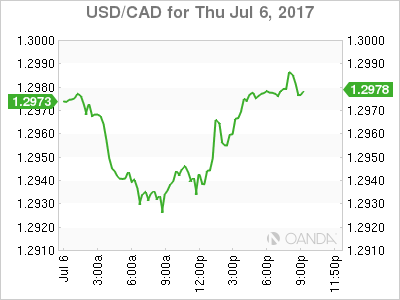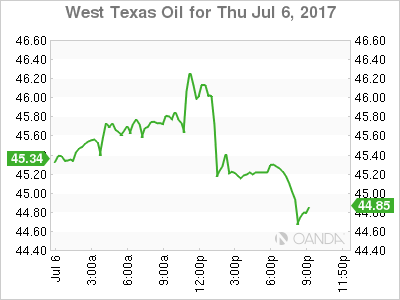The Canadian dollar appreciated against the US dollar on Thursday after the release of underperforming US economic indicators and a bigger drawdown of weekly crude inventories boosted the loonie. The Canadian currency has gained ever since Bank of Canada (BoC) senior policy makers have hinted at an upcoming rate hike. The market is pricing in a rising probability of a higher benchmark rate when the central bank meets on July 12.
Political risk has impaired the US dollar as the Trump administration has struggled to persuade republican senators to pass the healthcare reforms under consideration. The divisive proposal has reduced the political capital available to the Trump administration with the pro-growth policies still to see the light of day. The Trump trade got underway in December as infrastructure spending and fiscal stimulus was thought to be the first policies to be pushed through a Republican majority.
Oil prices rose as crude inventories in the US had a bigger drawdown than expected. Crude has been caught in a battle between Organization of the Petroleum Exporting Countries (OPEC) and other producers who signed a production cut agreement and Brazil, Canada and the United States who are part of the deal and have ramped up production.
The Canadian trade balance showed a rise in export and imports in May that marked records for both. The balanced showed a larger than expected $845 million it was explained by a one-time import of five airliners. Eight of the eleven export sectors have grown for three consecutive months. The trade data validates the optimism shown by the comments of BoC Governor about the Canadian economy.

The USD/CAD lost 0.239 in the last 24 hours. The currency pair is trading at 1.2953 after a mixed bag of economic indicators for the US dollar. The private payrolls ADP report disappointed with a 158,000 positions added, after a forecast of 184,000 and a downward revision that reduced by 23,000 last months massive gain. US unemployment claims came in higher than anticipated by a small margin but added to the pessimism about US employment. The ISM non-manufacturing PMI exceeded the forecast by reaching 57.4 in June. Both ISM surveys showed an overall strength in the manufacturing and services sectors.
The rise of oil prices after the lower than expected inventories boosted the CAD but the currency pair remains range bound ahead of the U.S. non farm payrolls (NFP) due on Friday, July 7 at 8:30 am EDT. The forecast for US jobs is for a gain of 175,000 new positions added in June. Last month’s report was 23,000 jobs lower than forecast and the slowdown in the private sector has raised concerns that it could come under forecasts. Given the focus of the Fed on inflation the market will be focusing on the average hourly earnings as a measure of inflation. Wages are forecasted to have grown 0.3 percent from last month.
Canadian employment data will also be released at the same time with a gain of 11,000 expected after the monster 54,500 gain last month. The CAD has appreciated since June 11 when the Bank of Canada (BoC) turned hawkish saying the rate cuts from 2015 have done their job. The central bank is widely anticipated to hike rates this year with the July 12 meeting at more than 50 percent probability.

Oil prices rose 0.5 percent on Thursday. The West Texas Intermediate is trading at $45.24 after the Energy Information Administration (EIA) weekly crude inventories report showed a bigger than expected drawdown. US crude stocks fell by 6.3 million barrels last week and let the total inventories at a six month low. The black stuff could not hold to most of the drawdown related gains as it backtracked as there are still concerns about oversupply. American output has increased and it has all but offset the efforts from the Organization of the Petroleum Exporting Countries (OPEC) who signed a production cut agreement with other major producers to limit the global supply.
The production cut agreement has enjoyed from full compliance in the first six months and was extended for another 9 after its effects have only managed to stabilize oil prices. Demand remains soft even as energy importing nations are running out of storage as they take advantage of current low prices.
Investment banks have reduced their price forecasts into the $50 to $55 price range for the end of the year. The battle between OPEC deal agreement producers and the US will continue to dictate the price of energy.
Market events to watch this week:
Friday, July 7
4:30 am GBP Manufacturing Production m/m
8:30 am CAD Employment Change
8:30 am CAD Unemployment Rate
8:30 am USD Average Hourly Earnings m/m
8:30 am USD Non-Farm Employment Change














